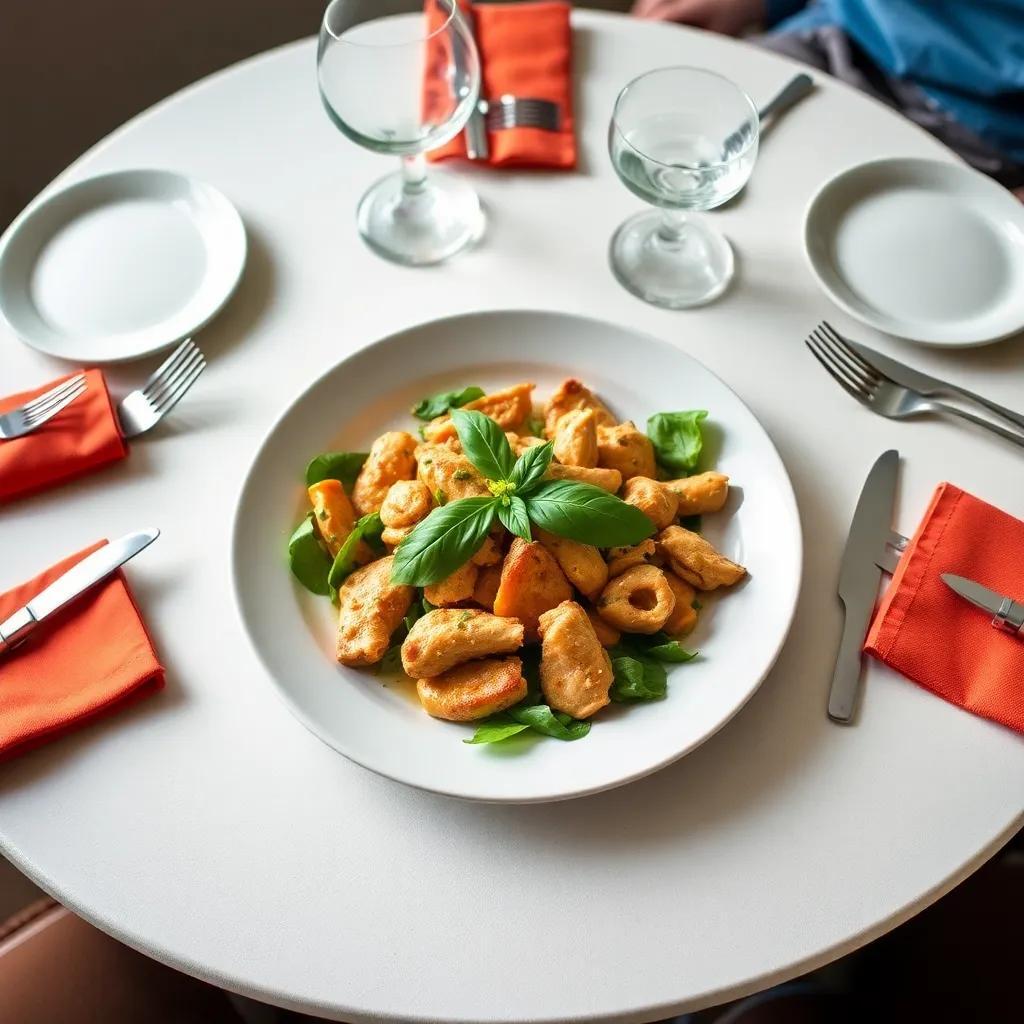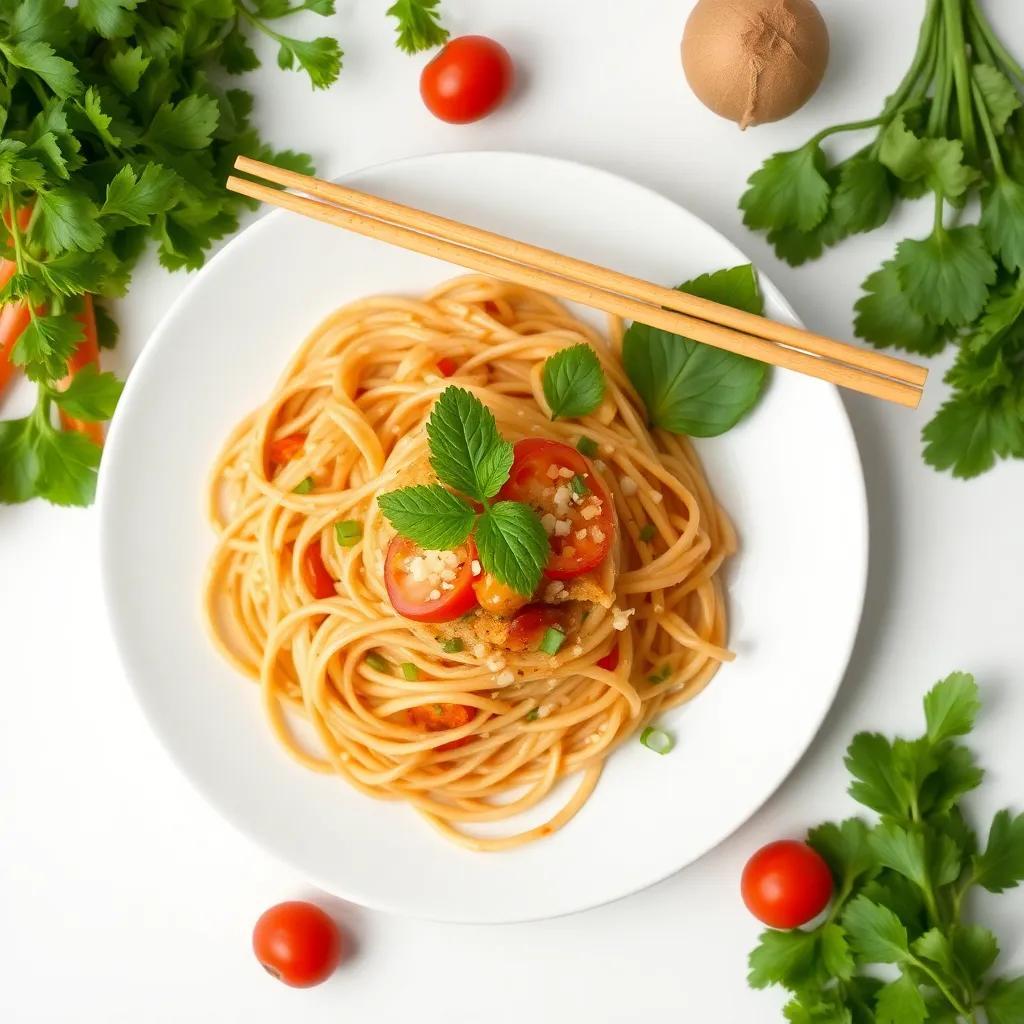Unlock Authentic Flavors: Easy Vegan Som Tum (Papaya Salad) Recipe
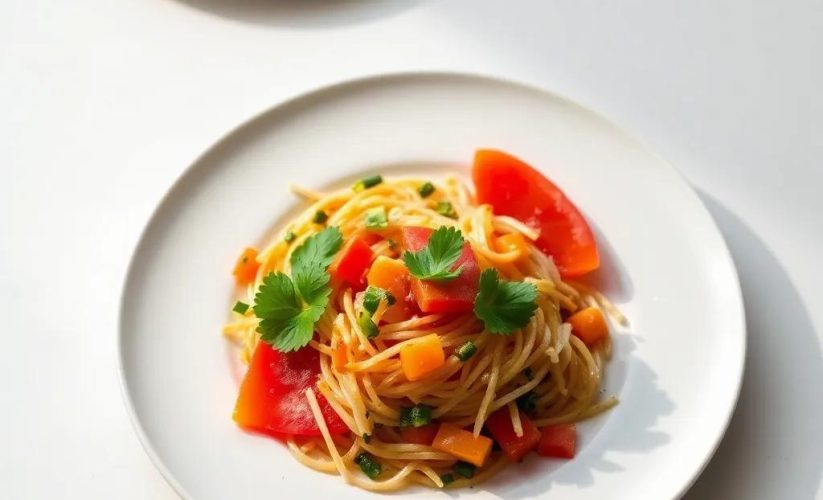
Unlock Authentic Flavors: Easy Vegan Som Tum (Papaya Salad) Recipe
🌍 Cuisine: Thai
⚙️ Difficulty: Easy
Ingredients
Nutrition Facts
120
Instructions
- Peel the green papaya and shred it finely using a grater or a mandoline slicer.
- In a large mixing bowl or a mortar and pestle, add minced garlic and chopped bird’s eye chilies. Pound or mash lightly to release their aroma.
- Add palm sugar, lime juice, and soy sauce or tamari into the bowl. Stir or lightly pound to dissolve the sugar and combine the flavors.
- Add the shredded papaya, cherry tomatoes, and cut green beans to the bowl.
- Gently toss and mix all ingredients together, slightly bruising the tomatoes and green beans to release their flavors.
- If using dried shrimp substitute or toasted seaweed flakes, add them now and mix well.
- Toast peanuts lightly in a dry pan or use pre-roasted peanuts. Crush them roughly and add half into the salad mix. Keep the rest for garnish.
- Taste and adjust seasoning by adding more lime juice, soy sauce, or sugar according to your preference.
- Transfer salad to a serving plate. Garnish with the remaining crushed peanuts and fresh coriander leaves.
- Serve immediately chilled or at room temperature as a refreshing vegan appetizer or side dish.
Serving Suggestions
- Serve alongside sticky rice and grilled vegetables for a complete vegan Thai meal.
- Pair with spicy vegan spring rolls or fresh summer rolls for an appetizer combo.
- Enjoy as a light lunch with a side of steamed tofu or tempeh for added protein.
- Top with crushed roasted cashews instead of peanuts for a different nutty flavor.
- Use as a vibrant topping for rice noodle bowls or vegan banh mi sandwiches.
- Complement with freshly squeezed coconut water or Thai iced tea for an authentic taste experience.
Table of Contents
- Intro
- Ingredient Notes
- Tips & Variations
- Leftovers & Storage
- Behind the Recipe
- FAQ
- Let’s Get Cooking!
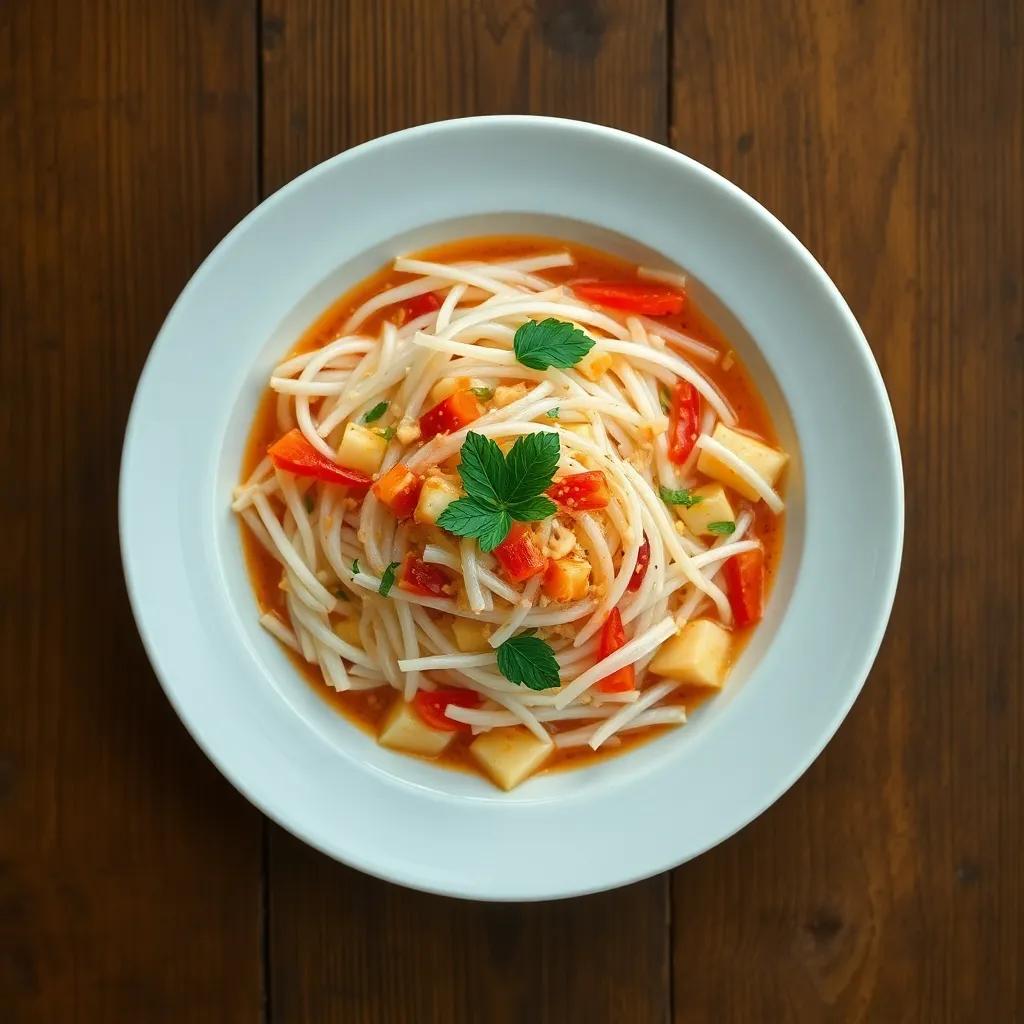
Intro
There’s something truly captivating about Som Tum, the vibrant Thai papaya salad that bursts with freshness and bold character in every bite. This easy vegan version invites you to explore a delightful balance of bright, tangy, spicy, and slightly sweet flavors—all without any fuss or lengthy prep. Whether you’re a seasoned plant-based foodie or simply curious about adding a fresh, zingy salad to your repertoire, this dish is a perfect go-to.
Ideal for warm weather gatherings, light lunches, or as a lively starter to an Asian-inspired feast, Som Tum manages to be both refreshing and satisfying. It’s a celebration of simple ingredients coming together into a dynamic harmony, made even better by how quickly it comes together—no cooking required! Plus, its crisp textures and aromatic qualities make it a standout on any table, encouraging conversation and second helpings.
If you love dishes that deliver authentic taste with minimal effort, this vegan Som Tum recipe is a wonderful gateway to the vibrant world of Thai cuisine and the joy of cooking something that’s as colorful on the plate as it is on the palate.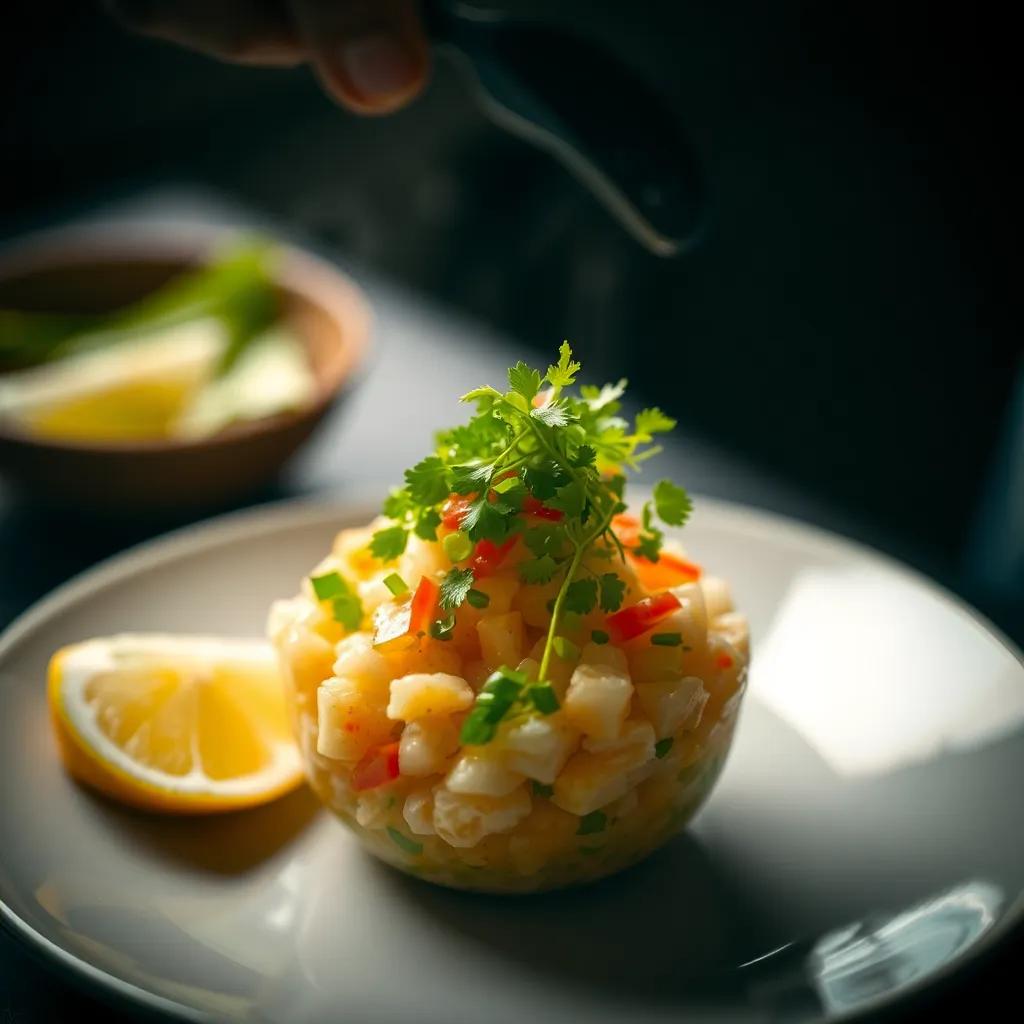
Ingredient Notes
When it comes to crafting an authentic vegan Som Tum, a few key ingredients truly shine in elevating this salad from simple to sensational. Understanding their roles and where to find them can make all the difference.
Green Papaya: The star of the dish, green papaya is prized for its firm, crisp texture and mild, slightly tart flavor. Unlike its ripe, sweet counterpart, the unripe green papaya lends a refreshing crunch that serves as the perfect canvas for the bold dressing. When selecting green papaya, look for one that is unripe and firm to the touch with smooth skin; it should not give easily when pressed. You can find it in Asian markets or well-stocked produce sections. If green papaya is unavailable, young green mango or shredded cucumber can be used as alternatives, though the flavor and texture will shift somewhat.
Palm Sugar: This unrefined sweetener adds a subtle caramel-like depth to balance the sour and spicy notes of the salad dressing. Palm sugar is less processed than brown sugar, offering a richer, more complex sweetness typical of traditional Thai cooking. When buying, choose blocks or granules that are light brown and free of excess moisture. If palm sugar is inaccessible, organic brown sugar or coconut sugar make good substitutes, keeping the delicate sweetness intact.
Thai Bird’s Eye Chilies: These tiny, potent chilies pack a fiery punch essential to Som Tum’s signature heat. Their fresh, sharp spiciness adds vibrant complexity and awakens the other flavors in the salad. When handling, add them gradually to adjust the heat level to your comfort. If you can’t find bird’s eye chilies, serrano or jalapeño peppers can serve as milder stand-ins, though the flavor will be less authentic.
Dried Shrimp Substitute (Toasted Seaweed Flakes): For a vegan twist that mimics the umami essence traditionally imparted by dried shrimp, toasted seaweed flakes are an ingenious choice. They contribute a briny, oceanic depth without overpowering the fresh ingredients. Look for plain roasted nori flakes in Asian grocery stores or online. If you prefer to omit any seafood-like flavor, simply leave this ingredient out—your salad will still be vibrant and delicious.
By paying attention to these distinctive ingredients, you’ll capture the authentic textures and layers that make Som Tum a beloved dish. Each element harmonizes to create the bright, balanced, and refreshingly bold flavors that invite repeated enjoyment.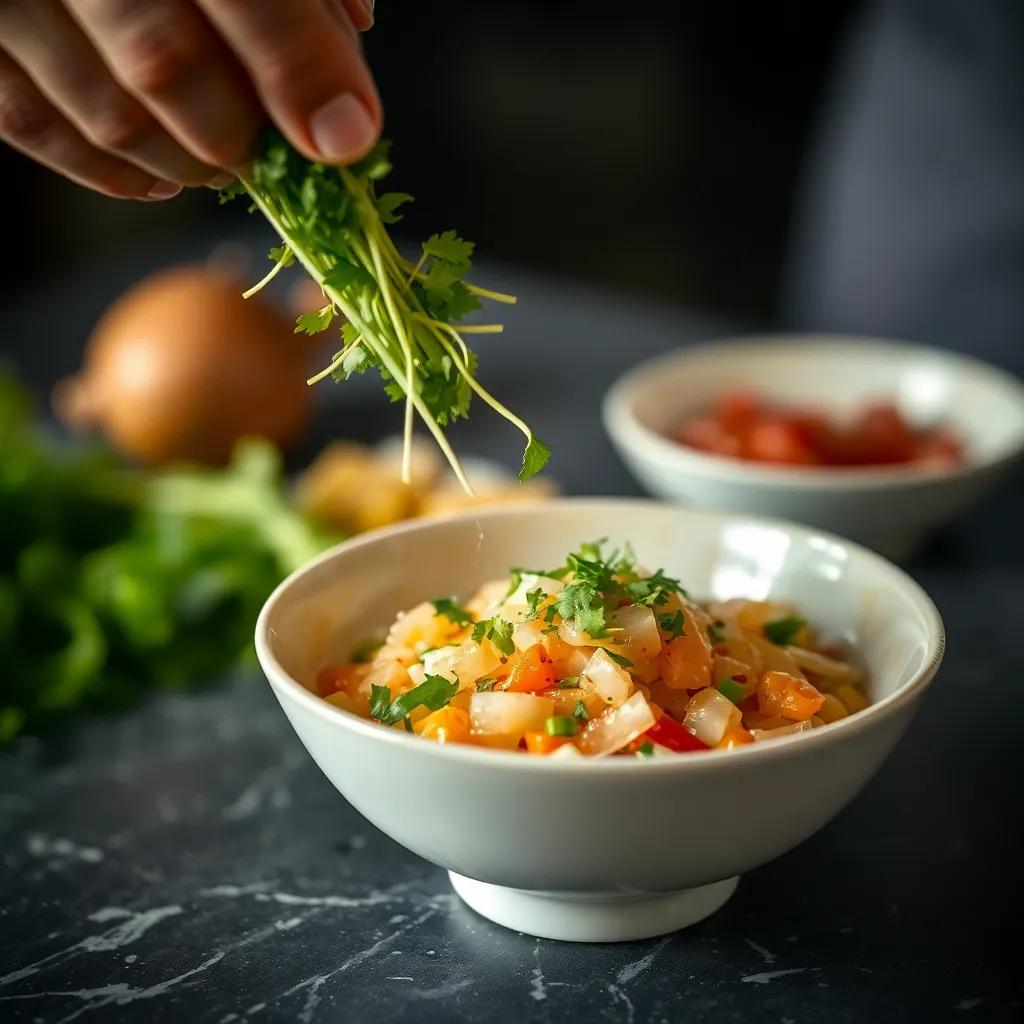
Tips & Variations
Mastering the art of vegan Som Tum means embracing both tradition and creativity. Here are some tips and variations to help you customize this vibrant papaya salad for your kitchen and palate:
- Balance Is Key: Som Tum shines when the flavors—spicy, sour, sweet, and salty—are in harmony. Taste as you go, adjusting lime juice for tang, palm sugar for sweetness, and chilies for heat. Remember, the boldness can be tailored to your mood or audience.
- Textural Play: To mimic the authentic crunch, shred the green papaya as finely as possible. For a slightly softer bite, let the shredded papaya sit in cold water for 10 minutes before draining. It mellows the texture slightly without losing the characteristic crispness.
- Alternative Vegetables: If green papaya is unavailable or you want to switch things up, try using shredded green mango, jicama, or even crisp cucumber. Each will bring a unique flavor twist—green mango offers tanginess, jicama lends a subtle sweetness, and cucumber keeps it refreshing.
- Chili Varieties & Heat Levels: Bird’s eye chilies provide traditional heat, but if you prefer milder spice, slice in jalapeños or Fresno peppers. For more complex heat, experiment with a pinch of smoked paprika or chili flakes. Seed removal can also tame the heat while preserving flavor.
- Sweetener Swaps: While palm sugar offers an authentic flavor, brown sugar or coconut sugar work well too. Agave syrup or maple syrup can be used for a liquid sweetener option, but add sparingly to avoid making the dressing too runny.
- Umami Boosters: The vegan dried shrimp substitute (toasted seaweed flakes) adds that oceanic umami kick. Alternatively, finely chopped shiitake mushrooms, miso paste dissolved in the dressing, or a dash of tamari can deepen flavor layers without animal products.
- Nut Choices: Peanuts are traditional, but experiment with roasted cashews, almonds, or even sunflower seeds for a nutty crunch that suits your preference or allergies. Toasting nuts lightly enhances their aroma and flavor.
- Make It Gluten-Free: Use tamari or coconut aminos instead of regular soy sauce to keep the dressing gluten-free without compromising on that essential salty note.
- Serving Ideas: Turn Som Tum into a meal by pairing it with protein-rich vegan sides like grilled tofu or tempeh. For a low-carb option, enjoy it as a vibrant bed for spiralized zucchini noodles or serve it atop leafy greens for a hearty salad bowl.
- Prepare in Advance: To preserve freshness, store shredded papaya separately from dressing and mix just before serving. This prevents sogginess and keeps the salad crisp.
By using these suggestions, you can make your vegan Som Tum uniquely yours while maintaining its lively spirit—a dish that invites you to taste, tweak, and enjoy the dance of flavors with every bite.
Leftovers & Storage
Leftover vegan Som Tum can be a delicious treat to enjoy again, but because of its fresh, vibrant ingredients and zesty dressing, proper storage is key to maintaining its crispness and bold flavors. Here’s how you can keep your papaya salad tasting fresh and bright after the first serving:
Som Tum is best enjoyed fresh since the shredded green papaya and crunchy veggies tend to soften over time as they absorb the dressing. To preserve texture, store any leftovers in an airtight container in the refrigerator within two hours of preparation. Use a glass or BPA-free plastic container with a tight-fitting lid to prevent moisture loss and unwanted odor absorption.
Because the salad’s lime juice and soy sauce dressing has no cooking involved, the salad will stay safe to eat for about 1 to 2 days in the fridge. Beyond this period, the papaya and green beans may become mushy, and the flavors will start to mellow out, losing that signature zesty snap. For optimal freshness, consume leftovers preferably within 24 hours.
If you anticipate making Som Tum ahead of time or want to meal prep, consider keeping components separate. Store the shredded green papaya, tomatoes, and beans in one container and the dressing in another. Combine them just before serving to maintain the crisp crunch and vibrant flavors. This method works especially well if you plan to pack the salad for lunch or a picnic.
Freezing is not recommended for Som Tum, as the raw vegetables and dressing lose their texture and freshness when thawed, often becoming watery and limp. Instead, rely on refrigerator storage for any leftovers.
When packing Som Tum to take on the go, use a sturdy lunch container and keep the dressing separate if possible. Pack crushed peanuts and fresh cilantro separately as well to add on top just before eating — this preserves their crunch and bright aroma.
Following these simple storage tips ensures your vegan Som Tum stays as lively and appetizing as when first made, letting you savor its authentic flavors even the next day.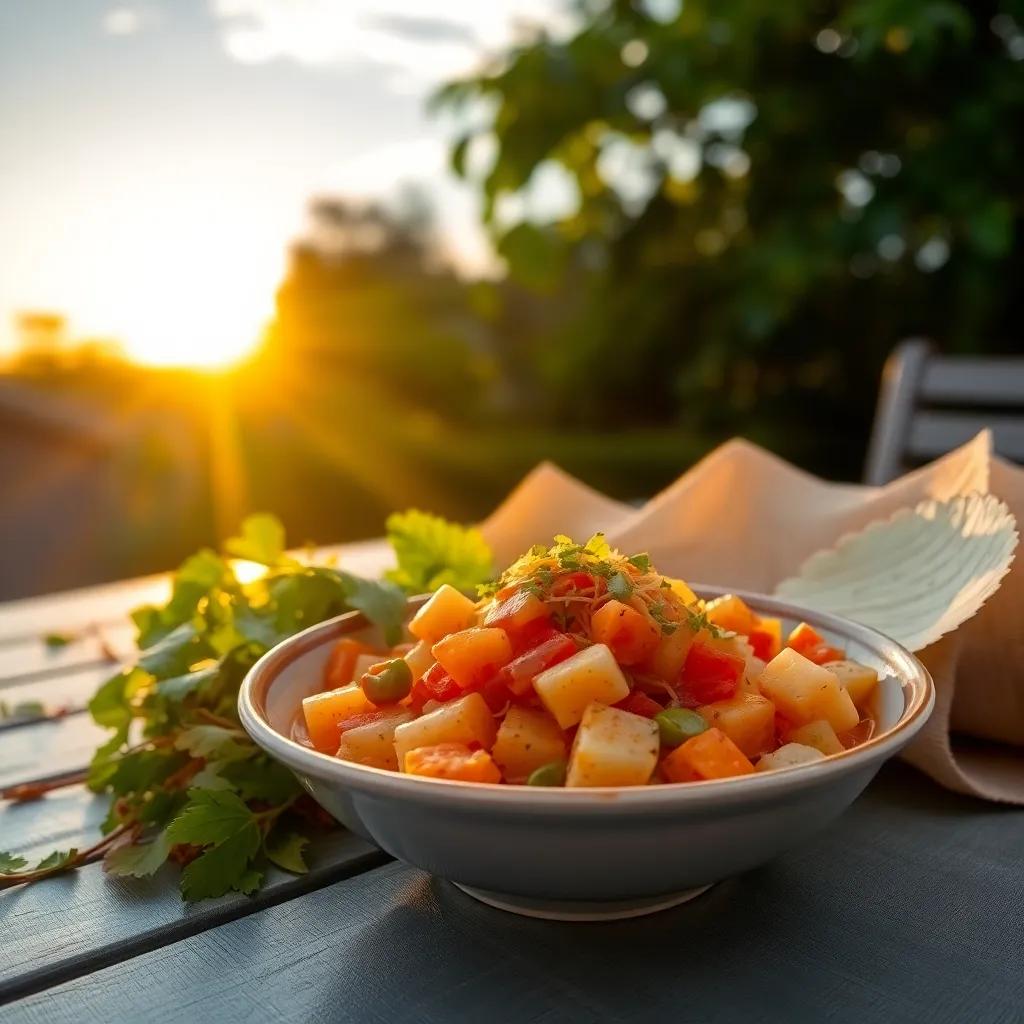
Behind the Recipe
Som Tum, or Thai green papaya salad, holds a special place in the culinary tapestry of Thailand, where it originated as a humble yet beloved street food. Traditionally crafted by pounding fresh, crunchy green papaya with aromatic herbs, fiery chilies, tangy lime, and sweet, savory seasonings, Som Tum embodies the vibrant balance of flavors that define Thai cuisine. Its roots trace back to the northeastern region of Isan, where it was—and still is—a daily staple enjoyed by locals to refresh the palate and complement heartier, spice-forward dishes.
The magic of Som Tum lies not just in its bold, harmonious taste but in its communal spirit. Often prepared with a mortar and pestle, the gentle pounding releases complex aromas and textures, inviting cooks and diners alike into a shared experience of flavor discovery. For many, Som Tum evokes memories of bustling markets, roadside vendors, and social gatherings centered around food that celebrates freshness and simplicity.
This vegan adaptation honors that tradition while embracing modern, plant-based needs. By substituting dried shrimp with toasted seaweed flakes and using tamari in place of fish sauce, the recipe preserves the umami depth and authenticity without compromising on dietary choices. It’s a nod to the growing global appreciation for Thai flavors, made accessible in home kitchens around the world.
For me personally, encountering Som Tum was a revelation—an introduction to how a simple salad can be intensely flavorful and refreshingly satisfying. Cooking this dish connects me to the vibrant street scenes of Thailand and the artistry of balancing heat, sourness, sweetness, and saltiness. Sharing it with friends always stirs curiosity and delight, proving that authentic flavors transcend borders and diet preferences alike. This recipe invites you not just to taste Som Tum but to experience a small, flavorful piece of Thai culture in your own home.
FAQ
Can I use a food processor instead of shredding the papaya by hand?
What can I substitute for fish sauce to keep this recipe vegan?
How long can I store leftover Som Tum, and will it stay fresh?
Can I customize the spice level in this Som Tum recipe?
Are there any good ingredient swaps if I can’t find green papaya?
Is it possible to freeze Som Tum for later?
Let’s Get Cooking!
There’s something truly special about Som Tum—the way fresh, zesty flavors come together in perfect harmony to create a vibrant, authentic taste that’s both refreshing and satisfying. This easy vegan version invites you to unlock those bold, tangy notes with simple ingredients, making it a delightful addition to your cooking repertoire. Whether you’re a seasoned vegan or just curious to try something new, this recipe is sure to brighten your table and your taste buds.
Give it a go, and don’t forget to share how it turns out! We’d love to hear your thoughts, see your creative twists, or know what sides you paired it with. Drop a comment, leave a rating, or pass this recipe along to friends eager to explore the delicious world of plant-based Thai cuisine!











